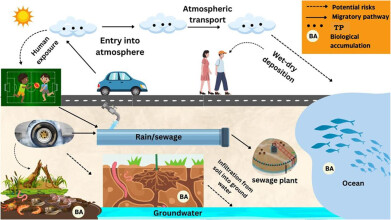Microplastics analysis
Study calls for tyre particles to be recognised as a distinct environmental threat
Nov 15 2024
A new study led by an international team of scientists has raised alarms about the growing environmental and health risks posed by tyre particles (TPs), urging for their classification as a separate category of pollution. Tyre particles, which account for nearly one-third of all microplastics, are uniquely hazardous due to their chemical complexity, size variation, and behaviour in ecosystems, making them distinct from conventional microplastics. Researchers are calling for urgent, targeted research to better understand their impact and the risks they pose to public health and the environment.
According to Henry Obanya, from the Institute of Marine Science and the Revolution Plastics Institute at the University of Portsmouth, “While tyre particles are classified as microplastics, they are much more complex. They contain hundreds of unknown chemicals, many of which leach into the environment and pose significant, unstudied risks. Our study urges that TPs be separated from traditional microplastics and recognised as a unique environmental threat. We need focused research to track their pathways and assess their impact.”
Why tyre particles need special attention
Unlike conventional microplastics, which are primarily made of simpler polymer chains, tyre particles are composed of a complex mix of synthetic and natural rubber, along with a variety of additives such as polyaromatic hydrocarbons, heavy metals, and stabilising chemicals. As tyre particles degrade in the environment, these substances can leach out, making TPs chemically distinct and potentially more harmful.
Additionally, tyre particles differ from typical microplastics in both size and dispersion. While traditional microplastics are usually smaller than 5 mm, TPs range in size, with some particles exceeding 5 mm. They are carried into ecosystems through road runoff, wind, and wear and tear, eventually settling in waterways, soils, and even entering food chains. This broad distribution and their chemical complexity make TPs a significant environmental concern that is not fully understood.
The study points to significant gaps in current research, including the lack of knowledge about the environmental presence, movement, and toxicity of these particles. To address this, the authors identify ten key research questions across four critical areas: environmental detection, chemical composition, biological impacts, and regulation. The research was conducted by an interdisciplinary team of experts from the UK, US, Norway, Australia, South Korea, Finland, Austria, China, and Canada, and highlights the need for a standardised framework to assess and manage tyre particles and the chemicals they release into the environment.
Calls for transparency and global action
A key recommendation from the study is the need for greater transparency in the tyre manufacturing industry, particularly regarding the chemicals used in production. Due to industrial confidentiality, little is known about the specific compounds present in tyre particles, which limits research efforts. However, studies have shown that chemicals leaching from TPs, particularly a tyre additive called 6PPD and its transformation product 6PPD-Q, have been linked to mass fish die-offs in North America.
The researchers also advocate for the creation of an intergovernmental science-policy panel on chemicals, waste, and pollution to address the global issue of tyre particle pollution. By prioritising research in these areas, policymakers and regulators could reduce uncertainties, improve risk assessments, and develop better strategies for mitigating the environmental and health impacts of TPs. The researchers envision that a clear classification and targeted regulatory framework could drive sustainable solutions in the tyre and automotive industries, helping to achieve broader global environmental goals.
“This study is a call to action for coordinated international efforts,” said Henry Obanya. “By recognising TPs as a distinct environmental threat, we can guide future research, shape policy, and work towards a more sustainable, healthier world.”
A roadmap for future research
Dr. Farhan R. Khan, Senior Researcher at the Norwegian Research Centre (NORCE) and a study contributor, emphasised the importance of a comprehensive, interdisciplinary approach. “This study brings together experts in environmental science, analytical detection, toxicology, and policy to provide a snapshot of where the research stands today. Importantly, it also lays out the key questions that need to be addressed moving forward.”
Dr. Imari Walker-Franklin, a researcher at RTI International and another study contributor, added, “Not only does this investigation highlight the urgent questions surrounding tyre particle pollution, but it also offers actionable steps for researchers, industry stakeholders, and regulators to take.”
Ongoing research into tyre particles’ impact on marine life
In a related effort, Henry Obanya is currently leading a study investigating the impact of chemicals and particles from vehicle tyres on marine life in UK waters. The project, a collaboration between the University of Portsmouth and Emissions Analytics Ltd, aims to measure the concentrations of additives found in UK aquatic environments and examine the varying toxicity of tyre particles from different manufacturers. This research, sponsored by the Petroleum Technology Development Fund (PTDF), will provide valuable data on the environmental risks posed by tyre particle pollution in marine ecosystems.
The study's findings are a powerful reminder of the urgent need to better understand and address the environmental impact of tyre particles.
Digital Edition
IET 35.2 March
April 2025
Air Monitoring - Probe Sampling in Hazardous Areas Under Extreme Conditions - New, Game-Changing Sensor for Methane Emissions - Blue Sky Thinking: a 50-year Retrospective on Technological Prog...
View all digital editions
Events
May 06 2025 Nuremberg, Germany
May 10 2025 Karachi, Pakistan
May 11 2025 Vienna, Austria
May 11 2025 Seoul, South Korea
Salon Analyse Industrielle & Instrumentation
May 14 2025 Paris, France





.jpg)

_(4427399123)-(2).jpg)











